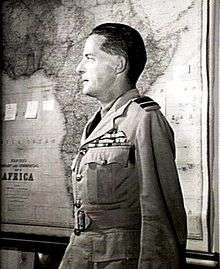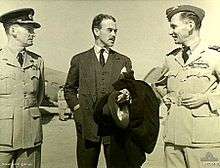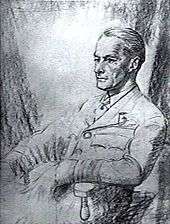Peter Drummond (RAF officer)
| Sir Peter Roy Maxwell Drummond | |
|---|---|
 Air Commodore Peter Drummond, 1940 | |
| Born |
2 June 1894 Perth, Western Australia |
| Died |
27 March 1945 (aged 50) Azores |
| Allegiance |
Australia United Kingdom |
| Service/branch | Royal Air Force |
| Years of service | 1914–45 |
| Rank | Air Marshal |
| Unit | No. 1 Squadron AFC (1917) |
| Commands held |
No. 145 Squadron RAF (1918–19) No. 111 Squadron RAF (1919) RAF Tangmere (1931–33) RAF Northolt (1936–37) Air Member for Training (1943–45) |
| Battles/wars |
World War I World War II |
| Awards |
Knight Commander of the Order of the Bath Distinguished Service Order & Bar Officer of the Order of the British Empire Military Cross Mentioned in Despatches (4) Commander of the Order of the Phoenix (Greece) |
Air Marshal Sir Peter Roy Maxwell Drummond, KCB, DSO & Bar, OBE, MC (2 June 1894 – 27 March 1945) was an Australian-born senior commander in the Royal Air Force (RAF). He rose from private soldier in World War I to air marshal in World War II. Drummond enlisted in the Australian Imperial Force in 1914 and saw action during the Gallipoli Campaign the following year. He joined the Royal Flying Corps in 1916 and became a fighter ace in the Middle Eastern theatre. Transferring to the RAF on its formation in 1918, he remained in the British armed forces for the rest of his life.
Between the wars, Drummond served for two years in the Sudan and for four years in Australia on secondment to the Royal Australian Air Force (RAAF), including a tour as Deputy Chief of the Air Staff. Based in Cairo at the outbreak of World War II, he was Air Marshal Sir Arthur Tedder's Deputy Air Officer Commanding-in-Chief RAF Middle East from 1941 to 1943. Drummond was twice offered command of the RAAF during the war but did not take up the position on either occasion. Britain's Air Member for Training from 1943, he was lost in a plane crash at sea in 1945.
Early career
Drummond was born in Perth, Western Australia, to merchant John Maxwell Drummond and his wife Caroline. Registered as Roy Maxwell Drummond, he acquired the nickname "Peter" during his schooling at Scotch College, and formally adopted it as his first name in 1943.[1][2] He served in the cadets and worked as a bank clerk before enlisting in the Australian Imperial Force on 10 September 1914.[1]
World War I
Soldier and pilot
At 5 ft 7in (171 cm) in height, Drummond was judged too slight of build for the infantry and was instead assigned to the 2nd Stationary Hospital of the Australian Army Medical Corps as an orderly. In December 1914, Drummond's unit arrived in Egypt. He was sent to Gallipoli in April 1915 and served on a hospital ship, assisting surgeons in candlelit operations on the wounded. Drummond was evacuated later that year, suffering from dysentery. In December, he applied for a transfer to the British Royal Flying Corps (RFC) and was discharged from the Australian Army in April 1916.[1]
Following pilot training in the United Kingdom, Drummond received the rank of temporary second lieutenant and was attached to No. 1 Squadron, Australian Flying Corps, which was based in Egypt.[1] During the Sinai and Palestine Campaign, he took part in the air assaults that preceded the Battle of Magdhaba on 23 December 1916. He later wrote, "The day before the Magdhaba battle, the whole crowd of us with all the bombs we could carry, went out. You couldn't see the place for smoke after we had left ... The Turks were retreating all the time and we had great sport coming down to about 50 feet and peppering them with machine guns ..."[3] On 20 March 1917, Drummond, flying a Royal Aircraft Factory B.E.2, was one of two pilots who strafed enemy troops threatening Lieutenant Frank McNamara as he rescued a downed Australian airman, the action for which McNamara was awarded his Victoria Cross.[4]
Flight commander and ace
Drummond became a flight commander with No. 1 Squadron (numbered 67 Squadron RFC by the British) in May 1917.[5] He was awarded the Military Cross in August for his "skill and courage on all occasions" after he and Lieutenant Adrian Cole engaged and drove off six enemy aircraft that were attempting to bomb Allied cavalry.[6][7] In October 1917, Drummond joined No. 111 Squadron RFC as a flight commander, with the temporary rank of captain.[1][8] On 12 December 1917, he and observer/gunner John Knowles were escorting two Australian aircraft in his Bristol Fighter near Tul Karem, Palestine, when they were spotted by three German Albatros scouts. Drummond attacked and destroyed all three of the enemy aircraft.[8] This achievement earned him the Distinguished Service Order for his "great skill and daring".[1][9]
On 27 March 1918, again near Tul Karem, Drummond and another pilot scrambled to attack a German scout. As his wingman dealt with the intruder, Drummond, flying a Nieuport, single-handedly engaged six other German aircraft that had suddenly appeared. After he had destroyed one and "sent another down in a spin", Drummond developed engine trouble and had to land behind enemy lines. Finding his engine firing again, he took off before he could be captured by Turkish troops and gained a start over the four still-circling German scouts, "who had also concluded that the fight was over". Drummond was forced to land three more times in enemy territory—once in a cavalry camp where he "carried away a line full of washing" with his undercarriage in his escape—before he shook off all but one of the pursuing fighters and landed safely behind Allied lines.[8] He was awarded a Bar to his DSO for his "gallant and successful" actions.[1][10]
Drummond kept the temporary rank of captain when the RFC merged with the Royal Naval Air Service to form the Royal Air Force on 1 April 1918. He was given command of No. 145 Squadron RAF on 19 July 1918, and made an acting major in September.[5] He finished the war an ace, with eight victories,[11][12][13] and was twice mentioned in despatches.[5]
Inter-war years
Drummond continued to serve in the RAF following World War I, taking command of No. 111 Squadron on 20 February 1919 and receiving his permanent commission as a flight lieutenant that August.[5] He was based in the Sudan in 1920–21, as part of Britain's system of "control without occupation", using aircraft instead of armies to put down local rebellions. As acting squadron leader, Drummond commanded "H" Unit, the entire complement of which consisted of two aircraft.[14] He was appointed an Officer of the Order of the British Empire on 22 July 1921 in recognition of his "excellent work" in the face of "adverse conditions", conducting a successful reconnaissance and bombing campaign against Garjak Nuer tribesmen.[5][15]
After returning to Britain, Drummond attended RAF Staff College, Andover, graduating in 1923. Seconded to the Royal Australian Air Force (RAAF) in 1925, he served as Deputy Chief of the Air Staff and as Director of Operations and Intelligence, before returning to the UK in 1929.[1][16] Drummond graduated from the Imperial Defence College, London, in December 1930, and was promoted wing commander on 1 July 1931. He commanded RAF Manston for a brief period in mid-1931, and later RAF Tangmere between November 1931 and June 1933. In September 1936 he was appointed Officer Commanding RAF Northolt, gaining promotion to group captain on 1 January 1937. He was posted to Cairo in September 1937 as Senior Air Staff Officer (SASO) RAF Middle East and raised to air commodore on 1 July 1939.[5]
World War II
Deputy Air Officer Commanding-in-Chief Middle East

Drummond was still in his position as SASO RAF Middle East when Britain declared war on 3 September 1939. Having been made an acting air vice marshal in June 1940, and temporary air vice marshal the following January, he was appointed acting Deputy Air Officer Commanding-in-Chief (AOC-in-C) RAF Middle East in May 1941, following Air Marshal Sir Arthur Tedder's elevation to acting AOC-in-C. Tedder's and Drummond's posts were made permanent in June 1941, Drummond being raised to acting air marshal.[5][11][17] Both officers have been credited with developing their command as "a mobile strike-force capable of co-operating fully with the other two services", and Tedder later remarked on the importance of his deputy's contribution to the Allied victory in North Africa.[1] Drummond was appointed a Companion of the Order of the Bath on 23 September 1941.[18]
In early 1942 the Australian Government sought Drummond for the position of Chief of the Air Staff (CAS) of the RAAF, to succeed Air Chief Marshal Sir Charles Burnett at the completion of the latter's two-year term.[19][20] Although initially supportive of the plan, the British Air Ministry eventually declined to release Drummond from his role in the Middle East, partly to avoid disruption to the region's command and also because it did not believe that Drummond's operational abilities would be put to sufficient use in the largely administrative role of CAS.[19] Drummond himself was reportedly dubious about the appointment because of the division of authority between RAAF Headquarters and Allied Air Force Headquarters, South West Pacific Area (SWPA).[21]
Air Chief Marshal Burnett had recommended his deputy, Air Vice Marshal William Bostock, for CAS but in May 1942 the position went to acting Air Commodore George Jones. Bostock in turn became Air Officer Commanding RAAF Command, Australia's main operational organisation under SWPA. An ongoing conflict between Jones (now promoted air vice marshal) and Bostock led to moves in April 1943 to bring in an officer senior to both men to head the RAAF in a unified command structure, and Drummond was once more approached by the Australian Government. Drummond had indicated that he was happy to serve in Australia but the Air Ministry again refused to release him, having selected him for a posting to the Air Council as Air Member for Training.[22][23]
Final posting and loss at sea

Drummond took up the position of Air Member for Training on 27 April 1943, succeeding Air Marshal Sir Guy Garrod.[24] He was promoted to temporary air marshal on 1 June 1943 and appointed a Knight Commander of the Order of the Bath. The following year he turned down the position of Air Commander-in-Chief South East Asia Command. Air Marshal Sir Trafford Leigh-Mallory accepted it instead, and died in an aircraft accident on his way to take up the post.[5] On 27 March 1945, Drummond was en route to Canada with other dignitaries to attend a ceremony marking the closure of the Empire Air Training Scheme. His plane, a B-24 Liberator nicknamed Commando that was formerly the personal transport of Winston Churchill, disappeared near the Azores and all aboard were presumed killed.[1][5]
Peter Drummond was survived by his wife Isabel, whom he married in Toorak, Victoria, while on loan to the RAAF in 1929, and their three children.[1] He was twice mentioned in despatches for his service in World War II, in 1942 and 1946.[5] On 3 May 1946, Drummond was posthumously granted permission to wear the award of Commander of the Order of the Phoenix, conferred by the Kingdom of Greece.[25]
Notes
- 1 2 3 4 5 6 7 8 9 10 11 McCarthy, Australian Dictionary of Biography, pp.39–40
- ↑ The London Gazette: (Supplement) no. 36042. p. 2588. 4 June 1943. Retrieved 21 October 2008.
- ↑ MacDougall, Australians at War, p.100
- ↑ Wilson, The Brotherhood of Airmen, pp.11–13
- 1 2 3 4 5 6 7 8 9 10 Air Marshal Sir Peter Drummond at Air of Authority – A History of RAF Organisation Archived 26 December 2007 at the Wayback Machine.. Retrieved 2 July 2012. Archived 26 December 2007 at the Wayback Machine.
- ↑ Recommendation for Roy Maxwell Drummond to be awarded a Military Cross at Australian War Memorial. Retrieved 6 April 2009.
- ↑ The London Gazette: (Supplement) no. 30234. p. 8365. 14 August 1917. Retrieved 17 October 2008.
- 1 2 3 Cutlack, The Australian Flying Corps, pp.87–91
- ↑ The London Gazette: (Supplement) no. 30862. pp. 9902–9903. 23 August 1918. Retrieved 17 October 2008.
- ↑ The London Gazette: (Supplement) no. 30813. p. 8736. 23 July 1918. Retrieved 17 October 2008.
- 1 2 Helson, Ten Years at the Top, p.54.
- ↑ Guttman, Bristol F.2 Fighter Aces of World War I, pp.76–78
- ↑ Newton, Australian Air Aces, pp.35,60
- ↑ Herington, Air War Against Germany and Italy, p.52
- ↑ The London Gazette: no. 32398. p. 5832. 22 July 1921. Retrieved 21 October 2008.
- ↑ Gillison, Royal Australian Air Force, p.712
- ↑ Marshal of the RAF Lord Tedder at Air of Authority – A History of RAF Organisation. Retrieved 2 July 2012.
- ↑ The London Gazette: (Supplement) no. 35284. p. 5567. 23 September 1941. Retrieved 21 October 2008.
- 1 2 Helson, Ten Years at the Top, pp.54–76
- ↑ Stephens, The Royal Australian Air Force, p.117
- ↑ Gillison, Royal Australian Air Force, pp.474–475
- ↑ Helson, Ten Years at the Top, pp.127–128,166–176
- ↑ Odgers, Air War Against Japan, pp.15–17
- ↑ Air Council Appointments 2 at Air of Authority – A History of RAF Organisation. Retrieved 30 December 2007.
- ↑ The London Gazette: no. 37553. p. 2127. 30 April 1946. Retrieved 21 October 2008.
References
| Wikimedia Commons has media related to Peter Roy Maxwell Drummond. |
- Cutlack, F.M. (1941) [1923]. The Official History of Australia in the War of 1914–1918 (11th edition): Volume VIII – The Australian Flying Corps in the Western and Eastern Theatres of War, 1914–1918. Sydney: Angus & Robertson. OCLC 220900299.
- McCarthy, John (1996). "Drummond, Sir Peter Roy Maxwell (1894–1945)". Australian Dictionary of Biography: Volume 14. Melbourne: Melbourne University Press. ISBN 978-0-52284-717-8.
- Gillison, Douglas (1962). Australia in the War of 1939–1945: Series Three (Air) Volume I – Royal Australian Air Force 1939–1942. Canberra: Australian War Memorial. OCLC 2000369.
- Guttman, Jon (2007). Bristol F.2 Fighter Aces of World War I. Oxford: Osprey. ISBN 978-1-84603-201-1.
- Helson, Peter (2006). Ten Years at the Top (Ph. D thesis). Sydney: University of New South Wales. OCLC 225531223.
- Herington, John (1954). Australia in the War of 1939–1945: Series Three (Air) Volume III – Air War Against Germany and Italy 1939–1943. Canberra: Australian War Memorial. OCLC 3633363.}
- MacDougall, A.K. (2007) [2002]. Australians at War: A Pictorial History. Rowville, Victoria: Five Mile Press. ISBN 978-1-74178-957-7.
- Newton, Dennis (1996). Australian Air Aces. Fyshwyck, Australian Capital Territory: Aerospace Publications. ISBN 1-875671-25-0.
- Odgers, George (1968) [1957]. Australia in the War of 1939–1945: Series Three (Air) Volume II – Air War Against Japan, 1943–1945. Canberra: Australian War Memorial. OCLC 11218821.
- Stephens, Alan (2006) [2001]. The Royal Australian Air Force: A History. London: Oxford University Press. ISBN 0-19-555541-4.
- Wilson, David (2005). The Brotherhood of Airmen. Crows Nest, New South Wales: Allen & Unwin. ISBN 1-74114-333-0.
| Military offices | ||
|---|---|---|
| Preceded by Sir Guy Garrod |
Air Member for Training 1943–1945 |
Succeeded by Sir Roderic Hill |